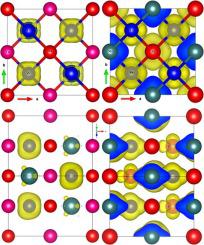当前位置:
X-MOL 学术
›
Inorg. Chem. Commun.
›
论文详情
Our official English website, www.x-mol.net, welcomes your feedback! (Note: you will need to create a separate account there.)
Electronic band structure, phase stability, magnetic and thermoelectric characteristics of the quaternary Heusler alloys CoCuZrAs and CoRhMoAl: Insights from DFT computations
Inorganic Chemistry Communications ( IF 3.8 ) Pub Date : 2021-02-01 , DOI: 10.1016/j.inoche.2020.108384 Muhammad Mushtaq , Saubia Khalid , Muhammad Atiff Sattar , Rabah Khenata , Taieb Seddik , Sajad Ahmad Dar , Iltaf Muhammad , S. Bin Omran
Inorganic Chemistry Communications ( IF 3.8 ) Pub Date : 2021-02-01 , DOI: 10.1016/j.inoche.2020.108384 Muhammad Mushtaq , Saubia Khalid , Muhammad Atiff Sattar , Rabah Khenata , Taieb Seddik , Sajad Ahmad Dar , Iltaf Muhammad , S. Bin Omran

|
Abstract The search for new materials with stable structures and unique functional properties is important for the development of future technologies. Herein, by performing first-principles calculations based on density functional theory (DFT), we have explored two new quaternary Heusler alloys, CoCuZrAs and CoRhMoAl. The total energy calculations reveal that CoCuZrAs (CoRhMoAl) is stable in the Y2 (Y1)-type structure among the three possible atomic configurations and that both alloys are ferromagnetic in the ground state. Electronic properties computed at the GGA level show that the present alloys have metallic behavior, whereas CoRhMoAl is a half-metal at GGA+U (U≥1 eV) due to the opening of a band gap at the Fermi level in the spin-down channel. Furthermore, CoRhMoAl retains its half-metallicity when pressure is applied (in the range of 0-25 GPa). The magnetic data reveal that CoCuZrAs has a total spin moment of 2.34 µB, whereas CoRhMoAl has an integral spin moment of 3.0 µB, which is in line with the Slater-Pauling formula Mt=Zt-24 (where Mt= total spin moment/cell, Zt= total valence electrons/cell). In CoCuZrAs, the Co, Cu, Zr and As atoms contribute individual spin moments of 2.16 µB, -0.03 µB, 0.18 µB and 0.04, respectively, whereas in CoRhMoAl, the Co, Rh, Mo, and Al atoms carry spin moments of 1.81, 0.17, 1.14 and -0.09 µB, respectively. These results are also supported by the corresponding spin density plots, where the spin density is mainly located at Co atoms. The thermoelectric properties calculated up to 1000 K exhibit interesting features that might be useful in energy production.
中文翻译:

四元赫斯勒合金 CoCuZrAs 和 CoRhMoAl 的电子能带结构、相稳定性、磁和热电特性:来自 DFT 计算的见解
摘要 寻找具有稳定结构和独特功能特性的新材料对于未来技术的发展具有重要意义。在此,通过基于密度泛函理论 (DFT) 进行第一性原理计算,我们探索了两种新的四元赫斯勒合金 CoCuZrAs 和 CoRhMoAl。总能量计算表明 CoCuZrAs (CoRhMoAl) 在三种可能的原子配置中的 Y2 (Y1) 型结构中是稳定的,并且两种合金在基态下都是铁磁性的。在 GGA 级计算的电子特性表明,本合金具有金属行为,而 CoRhMoAl 是 GGA+U (U≥1 eV) 的半金属,因为在自旋向下的费米能级处打开带隙渠道。此外,当施加压力(在 0-25 GPa 的范围内)时,CoRhMoAl 保持其半金属性。磁性数据显示 CoCuZrAs 的总自旋矩为 2.34 µB,而 CoRhMoAl 的积分自旋矩为 3.0 µB,这符合 Slater-Pauling 公式 Mt=Zt-24(其中 Mt= 总自旋矩/细胞, Zt = 总价电子/细胞)。在 CoCuZrAs 中,Co、Cu、Zr 和 As 原子的自旋矩分别为 2.16 µB、-0.03 µB、0.18 µB 和 0.04,而在 CoRhMoAl 中,Co、Rh、Mo 和 Al 原子的自旋力矩为 1.81 , 0.17, 1.14 和 -0.09 µB,分别。这些结果也得到相应的自旋密度图的支持,其中自旋密度主要位于 Co 原子。计算到 1000 K 的热电特性表现出可能对能源生产有用的有趣特征。磁性数据显示 CoCuZrAs 的总自旋矩为 2.34 µB,而 CoRhMoAl 的积分自旋矩为 3.0 µB,这符合 Slater-Pauling 公式 Mt=Zt-24(其中 Mt= 总自旋矩/细胞, Zt = 总价电子/细胞)。在 CoCuZrAs 中,Co、Cu、Zr 和 As 原子的自旋矩分别为 2.16 µB、-0.03 µB、0.18 µB 和 0.04,而在 CoRhMoAl 中,Co、Rh、Mo 和 Al 原子的自旋力矩为 1.81 , 0.17, 1.14 和 -0.09 µB,分别。这些结果也得到相应的自旋密度图的支持,其中自旋密度主要位于 Co 原子。计算到 1000 K 的热电特性表现出可能对能源生产有用的有趣特征。磁性数据显示 CoCuZrAs 的总自旋矩为 2.34 µB,而 CoRhMoAl 的积分自旋矩为 3.0 µB,这符合 Slater-Pauling 公式 Mt=Zt-24(其中 Mt= 总自旋矩/细胞, Zt = 总价电子/细胞)。在 CoCuZrAs 中,Co、Cu、Zr 和 As 原子的自旋矩分别为 2.16 µB、-0.03 µB、0.18 µB 和 0.04,而在 CoRhMoAl 中,Co、Rh、Mo 和 Al 原子的自旋力矩为 1.81 , 0.17, 1.14 和 -0.09 µB,分别。这些结果也得到相应的自旋密度图的支持,其中自旋密度主要位于 Co 原子。计算到 1000 K 的热电特性表现出可能对能源生产有用的有趣特征。而 CoRhMoAl 的积分自旋矩为 3.0 µB,这符合 Slater-Pauling 公式 Mt=Zt-24(其中 Mt= 总自旋矩/细胞,Zt= 总价电子/细胞)。在 CoCuZrAs 中,Co、Cu、Zr 和 As 原子的自旋矩分别为 2.16 µB、-0.03 µB、0.18 µB 和 0.04,而在 CoRhMoAl 中,Co、Rh、Mo 和 Al 原子的自旋力矩为 1.81 , 0.17, 1.14 和 -0.09 µB,分别。这些结果也得到相应的自旋密度图的支持,其中自旋密度主要位于 Co 原子。计算到 1000 K 的热电特性表现出可能对能源生产有用的有趣特征。而 CoRhMoAl 的积分自旋矩为 3.0 µB,这符合 Slater-Pauling 公式 Mt=Zt-24(其中 Mt= 总自旋矩/细胞,Zt= 总价电子/细胞)。在 CoCuZrAs 中,Co、Cu、Zr 和 As 原子的自旋矩分别为 2.16 µB、-0.03 µB、0.18 µB 和 0.04,而在 CoRhMoAl 中,Co、Rh、Mo 和 Al 原子的自旋力矩为 1.81 , 0.17, 1.14 和 -0.09 µB,分别。这些结果也得到相应的自旋密度图的支持,其中自旋密度主要位于 Co 原子。计算到 1000 K 的热电特性表现出可能对能源生产有用的有趣特征。Cu、Zr 和 As 原子的自旋矩分别为 2.16 µB、-0.03 µB、0.18 µB 和 0.04,而在 CoRhMoAl 中,Co、Rh、Mo 和 Al 原子的自旋矩为 1.81、0.17、1.14 和 -分别为 0.09 µB。这些结果也得到相应的自旋密度图的支持,其中自旋密度主要位于 Co 原子。计算到 1000 K 的热电特性表现出可能对能源生产有用的有趣特征。Cu、Zr 和 As 原子的自旋矩分别为 2.16 µB、-0.03 µB、0.18 µB 和 0.04,而在 CoRhMoAl 中,Co、Rh、Mo 和 Al 原子的自旋矩为 1.81、0.17、1.14 和 -分别为 0.09 µB。这些结果也得到相应的自旋密度图的支持,其中自旋密度主要位于 Co 原子。计算到 1000 K 的热电特性表现出可能对能源生产有用的有趣特征。
更新日期:2021-02-01
中文翻译:

四元赫斯勒合金 CoCuZrAs 和 CoRhMoAl 的电子能带结构、相稳定性、磁和热电特性:来自 DFT 计算的见解
摘要 寻找具有稳定结构和独特功能特性的新材料对于未来技术的发展具有重要意义。在此,通过基于密度泛函理论 (DFT) 进行第一性原理计算,我们探索了两种新的四元赫斯勒合金 CoCuZrAs 和 CoRhMoAl。总能量计算表明 CoCuZrAs (CoRhMoAl) 在三种可能的原子配置中的 Y2 (Y1) 型结构中是稳定的,并且两种合金在基态下都是铁磁性的。在 GGA 级计算的电子特性表明,本合金具有金属行为,而 CoRhMoAl 是 GGA+U (U≥1 eV) 的半金属,因为在自旋向下的费米能级处打开带隙渠道。此外,当施加压力(在 0-25 GPa 的范围内)时,CoRhMoAl 保持其半金属性。磁性数据显示 CoCuZrAs 的总自旋矩为 2.34 µB,而 CoRhMoAl 的积分自旋矩为 3.0 µB,这符合 Slater-Pauling 公式 Mt=Zt-24(其中 Mt= 总自旋矩/细胞, Zt = 总价电子/细胞)。在 CoCuZrAs 中,Co、Cu、Zr 和 As 原子的自旋矩分别为 2.16 µB、-0.03 µB、0.18 µB 和 0.04,而在 CoRhMoAl 中,Co、Rh、Mo 和 Al 原子的自旋力矩为 1.81 , 0.17, 1.14 和 -0.09 µB,分别。这些结果也得到相应的自旋密度图的支持,其中自旋密度主要位于 Co 原子。计算到 1000 K 的热电特性表现出可能对能源生产有用的有趣特征。磁性数据显示 CoCuZrAs 的总自旋矩为 2.34 µB,而 CoRhMoAl 的积分自旋矩为 3.0 µB,这符合 Slater-Pauling 公式 Mt=Zt-24(其中 Mt= 总自旋矩/细胞, Zt = 总价电子/细胞)。在 CoCuZrAs 中,Co、Cu、Zr 和 As 原子的自旋矩分别为 2.16 µB、-0.03 µB、0.18 µB 和 0.04,而在 CoRhMoAl 中,Co、Rh、Mo 和 Al 原子的自旋力矩为 1.81 , 0.17, 1.14 和 -0.09 µB,分别。这些结果也得到相应的自旋密度图的支持,其中自旋密度主要位于 Co 原子。计算到 1000 K 的热电特性表现出可能对能源生产有用的有趣特征。磁性数据显示 CoCuZrAs 的总自旋矩为 2.34 µB,而 CoRhMoAl 的积分自旋矩为 3.0 µB,这符合 Slater-Pauling 公式 Mt=Zt-24(其中 Mt= 总自旋矩/细胞, Zt = 总价电子/细胞)。在 CoCuZrAs 中,Co、Cu、Zr 和 As 原子的自旋矩分别为 2.16 µB、-0.03 µB、0.18 µB 和 0.04,而在 CoRhMoAl 中,Co、Rh、Mo 和 Al 原子的自旋力矩为 1.81 , 0.17, 1.14 和 -0.09 µB,分别。这些结果也得到相应的自旋密度图的支持,其中自旋密度主要位于 Co 原子。计算到 1000 K 的热电特性表现出可能对能源生产有用的有趣特征。而 CoRhMoAl 的积分自旋矩为 3.0 µB,这符合 Slater-Pauling 公式 Mt=Zt-24(其中 Mt= 总自旋矩/细胞,Zt= 总价电子/细胞)。在 CoCuZrAs 中,Co、Cu、Zr 和 As 原子的自旋矩分别为 2.16 µB、-0.03 µB、0.18 µB 和 0.04,而在 CoRhMoAl 中,Co、Rh、Mo 和 Al 原子的自旋力矩为 1.81 , 0.17, 1.14 和 -0.09 µB,分别。这些结果也得到相应的自旋密度图的支持,其中自旋密度主要位于 Co 原子。计算到 1000 K 的热电特性表现出可能对能源生产有用的有趣特征。而 CoRhMoAl 的积分自旋矩为 3.0 µB,这符合 Slater-Pauling 公式 Mt=Zt-24(其中 Mt= 总自旋矩/细胞,Zt= 总价电子/细胞)。在 CoCuZrAs 中,Co、Cu、Zr 和 As 原子的自旋矩分别为 2.16 µB、-0.03 µB、0.18 µB 和 0.04,而在 CoRhMoAl 中,Co、Rh、Mo 和 Al 原子的自旋力矩为 1.81 , 0.17, 1.14 和 -0.09 µB,分别。这些结果也得到相应的自旋密度图的支持,其中自旋密度主要位于 Co 原子。计算到 1000 K 的热电特性表现出可能对能源生产有用的有趣特征。Cu、Zr 和 As 原子的自旋矩分别为 2.16 µB、-0.03 µB、0.18 µB 和 0.04,而在 CoRhMoAl 中,Co、Rh、Mo 和 Al 原子的自旋矩为 1.81、0.17、1.14 和 -分别为 0.09 µB。这些结果也得到相应的自旋密度图的支持,其中自旋密度主要位于 Co 原子。计算到 1000 K 的热电特性表现出可能对能源生产有用的有趣特征。Cu、Zr 和 As 原子的自旋矩分别为 2.16 µB、-0.03 µB、0.18 µB 和 0.04,而在 CoRhMoAl 中,Co、Rh、Mo 和 Al 原子的自旋矩为 1.81、0.17、1.14 和 -分别为 0.09 µB。这些结果也得到相应的自旋密度图的支持,其中自旋密度主要位于 Co 原子。计算到 1000 K 的热电特性表现出可能对能源生产有用的有趣特征。


























 京公网安备 11010802027423号
京公网安备 11010802027423号